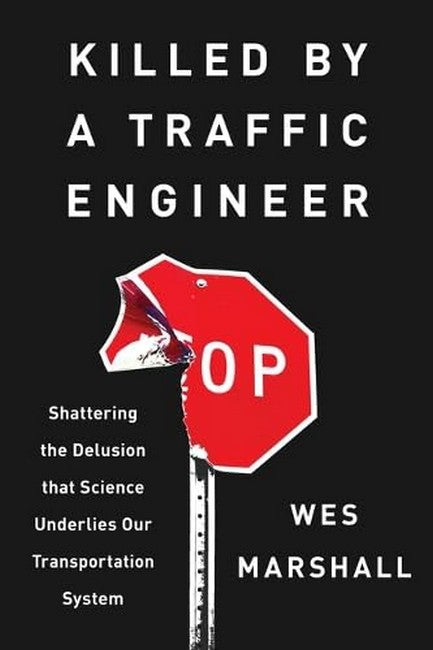Wes Marshall, PhD, PE, is professor of Civil Engineering with a joint appointment in Urban and Regional Planning at the University of Colorado Denver. He is also the director of the CU Denver Transportation Research Center and co-director of the Active Communities/Transportation (ACT) research group. He received his Professional Engineering license in 2003 and focuses on transportation teaching and research dedicated to creating a more sustainable and resilient world, particularly in terms of road safety. Having spent time in the private sector, Wes has been working on these issues for more than 25 years. With over 80 peer-reviewed publications, Wes was also the winner of the Campus-wide University of Colorado Denver Outstanding Faculty in Research Award.
Description
Part 1: What Are We Doing Here?
Chapter 1: Bad Medicine
Chapter 2: Deal or No Deal
Chapter 3: Murder Incorporated
Chapter 4: Hand-Me-Downs
Chapter 5: Passing the Buck
Chapter 6: Won’t Someone Please Think of the Children?
Chapter 7: Little Lies
Chapter 8: Science versus Faith
Chapter 9: Killed by a Traffic Engineer?
Chapter 10: The Three E’s
Chapter 11: You Could Learn a Lot from a Dummy
Chapter 12: License to Drive
Chapter 13: Good Cop, Bad Cop
Chapter 14: Can We Fix It?
Chapter 15: Fast Times
Chapter 16: Safety for Whom?
Chapter 17: Full of Hot Air
Chapter 18: How Much Is Your Life Worth?
Chapter 19: The Cost of Doing Business
Chapter 20: Do Better, Be Better
Part 2: Mismeasuring Safety
Chapter 21: The Relativity of Safety
Chapter 22: Exposing Exposure
Chapter 23: The Mirage of More Mileage
Chapter 24: Why Didn’t the Chicken Cross the Road?
Chapter 25: Don’t Sweat the Small Stuff
Chapter 26: The Conflict Conflict
Chapter 27: Conflating Congestion
Chapter 28: Aiming in the Wrong Direction
Part 3: Make No Mistake
Chapter 29: The Human Error False Flag
Chapter 30: What Is Predictable Is Preventable
Chapter 31: The Errors beneath the Errors
Chapter 32: Tip of the Wrong Iceberg
Chapter 33: Bad Apples
Chapter 34: Wishful Technological Thinking
Chapter 35: Not So Simple
Chapter 36: I Wish I Knew
Chapter 37: Why and Why Not?
Chapter 38: Cold, Wet, and a Little Embarrassed
Part 4: I Feel the Need for Speed
Chapter 39: Disconnecting Speed from Safety
Chapter 40: What’s Up with That?
Chapter 41: Reasonable and Prudent
Chapter 42: Lukewarm Chicken
Chapter 43: Be Careful What You Wish For
Chapter 44: Designing for Speed
Chapter 45: Above Minimum
Chapter 46: The Fundamental Physics
Chapter 47: Common Knowledge
Part 5: Designing Time
Chapter 48: Forecasting Overkill
Chapter 49: An Origin Story for the High-Injury Network
Chapter 50: It’s a Tradition
Chapter 51: One-Way Conflicts
Chapter 52: Inconvenient Evidence
Chapter 53: Unclear Zones
Chapter 54: The Fuzzy Math of Urban Freeways
Part 6: A Bird’s-Eye View
Chapter 55: Not If You Leave Your Cul-de-Sac
Chapter 56: What’s Your Function?
Chapter 57: Bigger and Badder
Chapter 58: Between Isn’t Through
Chapter 59: One Shining Moment
Chapter 60: Doing Our Jobs?
Chapter 61: Ain’t That America
Chapter 62: Well, That Didn’t Work
Part 7: OK Data, Don’t Mess This One Up
Chapter 63: Statistically Significant Nonsense
Chapter 64: Who Lives, Who Dies, Who Tells Your Story?
Chapter 65: We Don’t Know What We’re Missing
Chapter 66: Better Data, Better Insights
Part 8: The Blame Game
Chapter 67: The Liability Boogeyman
Chapter 68: The Guidelines Won’t Save Us
Chapter 69: Hard to Say I’m Sorry
Chapter 70: If Only
Chapter 71: Safer Designs Please
Part 9: Standard Issue
Chapter 72: The Pirates’ Code
Chapter 73: Don’t Blame the Manuals
Chapter 74: Level of Frickin’ Service
Chapter 75: Unfinished LOS Business
Chapter 76: Blind Faith in the Normal
Part 10: Safety Edumacation
Chapter 77: An Empty Silo
Chapter 78: Cultivating Engineering Judgment
Chapter 79: Generalists Are Special
Chapter 80: Transportation Is Made of People
Part 11: Spark Joy
Chapter 81: I Declare Vision Zero!
Chapter 82: Department of (Child) Transportation Services
Chapter 83: Where the Sidewalk Begins
Chapter 84: Another One Rides the Bus
Chapter 85: Won’t You Be My Neighbor?
Part 12: What Matters and What Next?
Chapter 86: Tell the Stories Behind the Numbers
Chapter 87: Reengineer the Traffic Engineers
Chapter 88: Keep Asking Why
About the Author
Acknowledgments
Endnotes
"Incisive debut polemic...Marshall’s breezy narrative, with section titles like What Are We Doing Here? plunges surprisingly deeply into the nitty-gritty of engineering standards, giving many specialist terms a vigorous, exasperated working-over. Transit nerds and advocates for safer streets will relish the detailed conceptual battle map drawn here."
-Publishers Weekly
"Finally, the whistleblower we’ve all been waiting for! Wes Marshall is much more than that—including a great storyteller—but with Killed by a Traffic Engineer, his role in history has been secured: pulling back the curtain and exposing the inner workings of an entire profession based on a foundation of the purest hooey."
-Jeff Speck, FAICP, author of Walkable City and Walkable City Rules
"I’ve been excited for this book since I first heard it was in the works. But when I actually got a chance to read it, it surpassed my expectations by a lot. Wes Marshall is not only authoritative, but a great writer. The problem he outlines is enormously consequential and has been criminally overlooked. I hope this book gets the attention it deserves."
-Angie Schmitt, author of Right of Way: Race, Class, and the Silent Epidemic of Pedestrian Deaths in America
"Very few transportation books remain influential 20 or 30 years after they are published. Wes Marshall’s Killed by a Traffic Engineer may well be one of them. It won’t let you look at our streets the same way ever again."
-Donald Shoup, author of The High Cost of Free Parking

